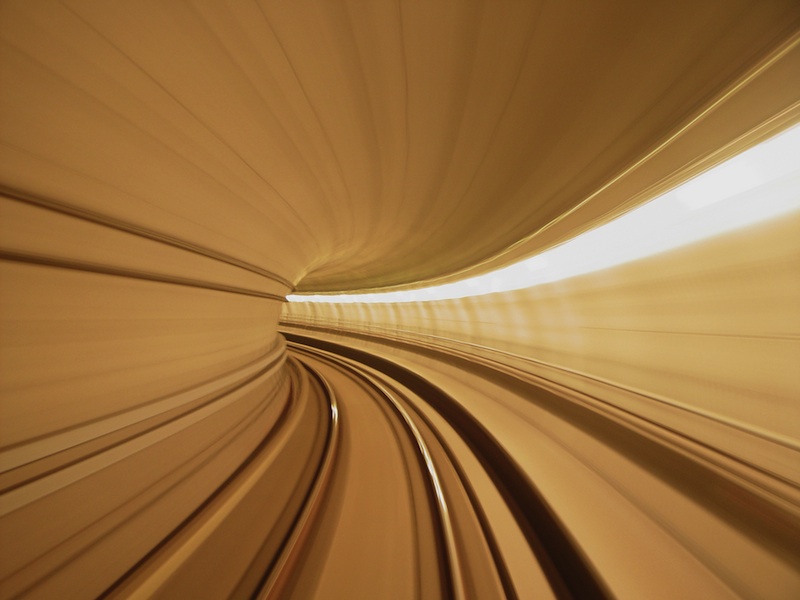
What would it be like to travel faster than the speed of light?
Is it even possible?

Physicists at the European Organization for Nuclear Research (CERN) have made a mind-bending — and rule-bending — discovery: They've measured strange subatomic particles called neutrinos traveling faster than the speed of light. "Superluminal travel" may be a common trope in science fiction, but Einstein's theory of special relativity strictly forbids it in the real world, as beating photons in a footrace would seem to require infinite energy.
So either the new data is wrong, or Einstein topples — along with almost every tenet of modern physics.
Imagine the latter scenario. What would a lawless universe, in which particles have free reign to zip around heedless of the light-speed limit, be like? How would your surroundings look and feel if you were that particle?
According to Michael Ibison, a senior research physicist at the Institute for Advanced Studies in Austin, Texas, such a world would be "spooky." First off, it's unclear how you would see light if you were zooming past it. "Thinking about what the world would look like automatically makes you wonder what happens to your ability to see light, period," Ibison, who has studied the possibility of superluminal particles, told Life's Little Mysteries. "You'd be running into [light] that is usually running away from you. I suspect that in order to absorb light, you would have to emit it yourself."
Related: What would happen if the speed of light was much lower?
The concepts of cause and effect — of time flowing in one direction — also shatter in a superluminal world. Imagine riding on a spacecraft made of faster-than-light neutrinos rocketing away from Earth. TV broadcasts playing the day's news are also emanating into space, and those are traveling at light speed. "If you got on a neutrino spacecraft and travelled out to space at neutrino speed, you'd catch up with the TV broadcasts and overtake them, and you would start to see the video of the news running backwards," Ibison said. As the stream of transmissions receded behind you, they would run backward at whatever your excess speed is over and above their speed — the speed of light.
What if you were standing still in a speed-limitless universe? What would you see then?
Sign up for the Live Science daily newsletter now
Get the world’s most fascinating discoveries delivered straight to your inbox.
According to Ibison, the situation is analogous to standing on the ground as a supersonic jet passes overhead. Because these jets travel faster than the speed of sound, you see them before you hear them. When the sound does finally hit you, it's in the form of a sonic boom — a shock wave that builds up as sound from the aircraft gets bunched together behind it.
Similarly, he said, "If something were traveling faster than the speed of light, such as an airplane made of neutrinos, you wouldn't see it until after it had gone past you. Any light it emitted would be trailing behind in its wake. You would not see the neutrino plane until after it has gone past — and then only if it contained something that reflected or emitted light. And just as a plane passing through the sound barrier emits a sonic boom, a superluminal craft passing through light speed would emit a flash of light."
Again, no one is saying for certain that these scenarios are real. According to Hugh Gallagher, a particle physicist at Tufts University who works on the MINOS neutrino experiment, the CERN result will have to be replicated many times over before he and his colleagues abandon the tenets of special relativity. "But if the results are true, then a lot of the things we don't think of as possible suddenly become open to discussion again," Gallagher said.
Originally published on Live Science.
Natalie Wolchover was a staff writer for Live Science from 2010 to 2012 and is currently a senior physics writer and editor for Quanta Magazine. She holds a bachelor's degree in physics from Tufts University and has studied physics at the University of California, Berkeley. Along with the staff of Quanta, Wolchover won the 2022 Pulitzer Prize for explanatory writing for her work on the building of the James Webb Space Telescope. Her work has also appeared in the The Best American Science and Nature Writing and The Best Writing on Mathematics, Nature, The New Yorker and Popular Science. She was the 2016 winner of the Evert Clark/Seth Payne Award, an annual prize for young science journalists, as well as the winner of the 2017 Science Communication Award for the American Institute of Physics.










